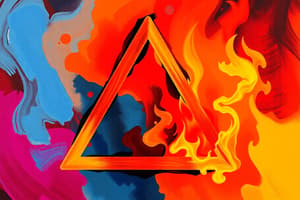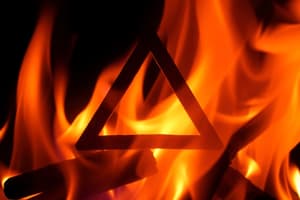Podcast
Questions and Answers
What are the three elements present in a fire?
What are the three elements present in a fire?
Fuel, oxygen, and heat
What is the key to preventing fire accidents?
What is the key to preventing fire accidents?
- Always having a fire extinguisher on hand
- Using water to extinguish fires
- Stopping the spread of fire (correct)
- Knowing the type of fire you are dealing with
What does MSDS stand for?
What does MSDS stand for?
Material Safety Data Sheet
What type of fire is caused by combustible metals like magnesium, potassium, and titanium?
What type of fire is caused by combustible metals like magnesium, potassium, and titanium?
Which of the following is NOT a method of fire extinguishing?
Which of the following is NOT a method of fire extinguishing?
The minimum or ______ temperature at which a liquid gives off enough vapor to form an ignitable mixture is called the flash point.
The minimum or ______ temperature at which a liquid gives off enough vapor to form an ignitable mixture is called the flash point.
Using a water extinguisher on a Class B fire caused by flammable liquids is an effective way to put out the fire.
Using a water extinguisher on a Class B fire caused by flammable liquids is an effective way to put out the fire.
Halon extinguishers are considered environmentally friendly due to their lack of harmful effects.
Halon extinguishers are considered environmentally friendly due to their lack of harmful effects.
What is the most widely used type of fire extinguisher?
What is the most widely used type of fire extinguisher?
What is the purpose of Hazard Communication (HazCom) Standard?
What is the purpose of Hazard Communication (HazCom) Standard?
The HazCom Standard requires all workplaces to have a mandatory fire safety training program.
The HazCom Standard requires all workplaces to have a mandatory fire safety training program.
What is the primary purpose of OSHA's standard 29 CFR (Code of Federal Regulations) 1910.120?
What is the primary purpose of OSHA's standard 29 CFR (Code of Federal Regulations) 1910.120?
Flashcards
What is fire?
What is fire?
A chemical reaction between a fuel, an oxidizer, and heat that produces light and heat.
What is Flash Point?
What is Flash Point?
The minimum temperature at which a liquid gives off enough vapor to ignite in the presence of an ignition source.
What is MSDS?
What is MSDS?
A document that provides information on the potential hazards and safety precautions associated with a chemical substance.
What is the fire triangle?
What is the fire triangle?
Signup and view all the flashcards
What is a water fire extinguisher?
What is a water fire extinguisher?
Signup and view all the flashcards
What is a dry powder fire extinguisher?
What is a dry powder fire extinguisher?
Signup and view all the flashcards
What is a CO2 fire extinguisher?
What is a CO2 fire extinguisher?
Signup and view all the flashcards
What is a wet chemical fire extinguisher?
What is a wet chemical fire extinguisher?
Signup and view all the flashcards
What is fire extinguishing?
What is fire extinguishing?
Signup and view all the flashcards
What is RACE?
What is RACE?
Signup and view all the flashcards
What is PASS?
What is PASS?
Signup and view all the flashcards
What is a Class B fire?
What is a Class B fire?
Signup and view all the flashcards
What is a Class D fire?
What is a Class D fire?
Signup and view all the flashcards
What is Halon?
What is Halon?
Signup and view all the flashcards
What is a dry powder fire extinguisher?
What is a dry powder fire extinguisher?
Signup and view all the flashcards
What is the Hazard Communication Standard (HazCom)?
What is the Hazard Communication Standard (HazCom)?
Signup and view all the flashcards
What is fire containment?
What is fire containment?
Signup and view all the flashcards
What is fire safety training?
What is fire safety training?
Signup and view all the flashcards
What is a fire alarm?
What is a fire alarm?
Signup and view all the flashcards
What is a Class C fire?
What is a Class C fire?
Signup and view all the flashcards
What is smothering?
What is smothering?
Signup and view all the flashcards
What is an automatic sprinkler system?
What is an automatic sprinkler system?
Signup and view all the flashcards
What is a Class A fire?
What is a Class A fire?
Signup and view all the flashcards
What is a hydrant system?
What is a hydrant system?
Signup and view all the flashcards
What is cooling?
What is cooling?
Signup and view all the flashcards
What is a Class K fire?
What is a Class K fire?
Signup and view all the flashcards
What is starving?
What is starving?
Signup and view all the flashcards
What is smoke detection?
What is smoke detection?
Signup and view all the flashcards
What is the Hazard Communication Standard (HazCom)?
What is the Hazard Communication Standard (HazCom)?
Signup and view all the flashcards
Study Notes
Course Information
- Course Title: MSDS And Fire Hazard
- University: University of Technology and Applied Sciences- Nizwa
- Country: Sultanate of Oman
- Course Code: EGHS1140
Fire Hazard Introduction
- Fire accidents cause severe injuries, fatalities, and death.
- Preventing fire spread is crucial for accident prevention.
- Fire is a chemical reaction where combustible materials react with oxygen, producing heat and carbon dioxide.
- Smoke contains particulates (SPM) and carbon monoxide, along with other combustion products.
Fire Hazards and Fire Protection
- All workplace measures must acknowledge and address fire protection, safety, prevention, and control.
Fire Triangle
- Fire requires three elements: fuel (flammable gas/liquid/solid), oxygen, and heat (ignition source).
- Depicted in a triangle called the fire triangle, where Fuel + Oxygen + Heat = Fire
- Removing any of these elements can stop or prevent a fire.
Fire Triangle Principle & Methods
- Fire can't start or persist without all three elements.
- Controlling fires involves removing one of these elements:
- Cooling: Removing the ignition source (e.g., using water)
- Starving: Limiting the fuel supply (e.g., removing combustibles)
- Smothering: Limiting the oxygen supply (e.g., using a fire blanket)
Cooling the System
- Methods involve removing heat from the fire, reducing the ignition temperature (e.g., using water).
Starving the Fire
- Limits the fuel supply by isolating flammable liquids/gases or removing materials (e.g., turning off electrical power).
Smothering the Fire
- Limits oxygen supply, stopping the mixing of oxygen and flammable vapors (e.g., fire blanket).
Fire Classification
- Fires are classified (A, B, C, D, and K) based on the fuel and the method of extinguishing.
- Class A: Fires involving common combustibles (wood, cloth, paper, rubber, plastic). Extinguished with water.
- Class B: Fires involving flammable liquids (e.g., gasoline, oil, grease). Extinguished with dry powder, CO2, Halon.
- Class C: Fires involving flammable gases (e.g., methane, LPG). Extinguished with CO2, Halon, or dry powder.
- Class D: Fires involving combustible metals (e.g., magnesium, potassium, titanium). Extinguished with special powders (sometimes sand).
- Class K: Fires involving combustible cooking oils and fats. Extinguished with wet chemical agents.
Flash Point
- Flash point is the minimum temperature a liquid needs to reach to produce enough vapor to create an ignitable mixture.
- Lower flash points indicate greater fire hazard risk.
- Flammable liquids have flash points below 100°F, sometimes at room temperature.
- Combustible liquids have flash points at or above 100°F.
Types of Fire Extinguishers
- Fire extinguishers remove one of the three fire triangle elements.
- Types include:
- Water (Class A)
- Dry Powder (Class A, B, C, D)
- CO2 and Halon (Class B, C)
- Wet Chemical (Class A, C, K)
Different Types of Fire Extinguishers (Images)
- Images depicting different fire extinguishers and their appropriate uses.
Class, Fuel, Extinguishers, and Fire Extinguishing Method
- Table summarizing fire classes, fuel types, appropriate extinguishers, and methods for extinguishing each type of fire.
Fire Extinguishing
- The act of putting out or reducing the spread of fire is called fire extinguishing.
- Commercial fire extinguishers exist for extinguishing.
Procedures to Follow During a Fire
- RACE (Rescue, Alarm, Contain, Extinguish) protocol to follow when a fire is discovered.
- Four key steps for immediate fire response:
- Rescue anyone in immediate danger.
- Sound the alarm and contact emergency services.
- Contain the fire by closing doors and windows.
- Extinguish small fires safely if possible.
Using a Fire Extinguisher (PASS)
- PASS acronym for the steps to use a fire extinguisher correctly:
- Pull safety pin.
- Aim nozzle at the base of the fire.
- Squeeze handle to release the extinguishing agent.
- Sweep nozzle back and forth at the base of the flames.
Halon
- Halon fire extinguishers contain chlorine derivatives and are effective fire suppressants.
- Halons can hinder the chain reaction of a fire.
- They are harmful to the ozone layer.
Dry Powder
- Dry powder extinguishers use ammonium phosphate, sodium bicarbonate, or potassium bicarbonate.
- They are widely used and more environmentally friendly than Halon extinguishers.
Other Precautions
- Signs and training for escape routes are essential.
- Avoid using lifts and escalators during fire emergencies.
- Ensure fire alarms are installed and readily available.
- Install fire detection/smoke detectors.
Additional Fire Safety Measures
- Hydrant systems provide water for firefighting.
- Automatic sprinkler systems should be installed to control fires.
Material Safety Data Sheets (MSDS)
- MSDS (Material Safety Data Sheet) is a critical communication tool from chemical suppliers.
- It contains various details about the hazardous ingredients, physical/mechanical characteristics, chemical properties, fire hazards, and more.
- This document also details explosion hazards, reactivity information, health hazards, precautions, safe handling procedures, and control measures.
Sections of MSDS
- MSDS includes 16 sections covering various hazardous information, following OSHA (Occupational Safety and Health Administration) standards.
- Different sections provide aspects relating or critical for understanding and handling hazardous or chemical substances, such as identification data, hazards, compositions, handling, storage, accidental releases, transport information, and more.
Hazard Communication (HazCom)
- HazCom is an international standard for handling and communicating chemical hazards to employees and the public.
- The key goal is to inform users of hazards, protective action, and protective measures for handling chemical materials.
- Standard requires labeling and MSDS for all substances.
Studying That Suits You
Use AI to generate personalized quizzes and flashcards to suit your learning preferences.




